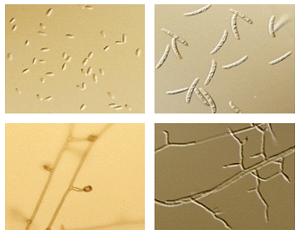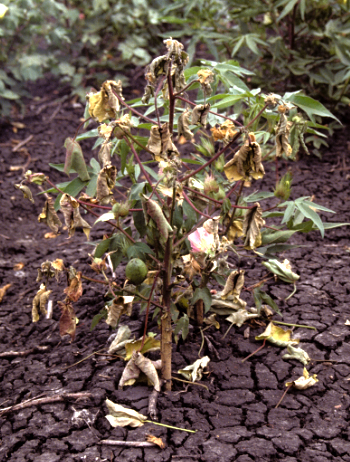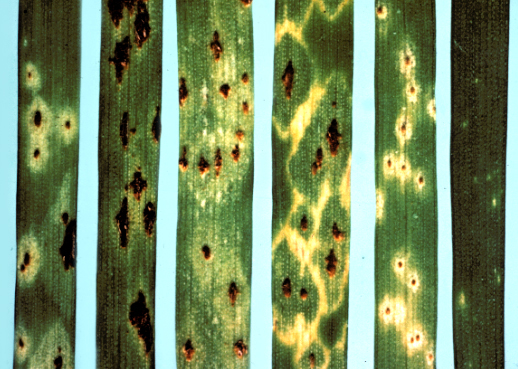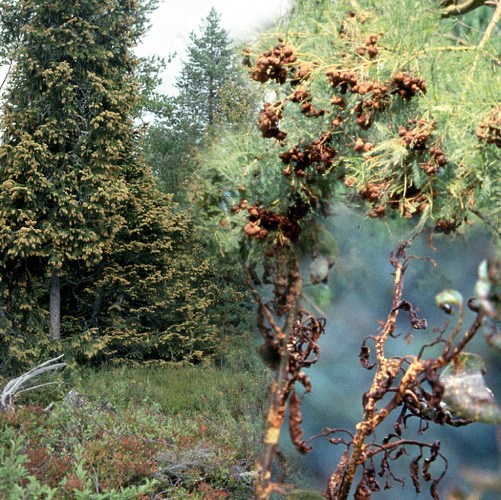Origin & Maintenance of Variation in Plant Pathogens

This project area is aimed towards developing an understanding of the relative importance of the different mechanisms (migration; sexual and asexual recombination; mutation) that contribute to the origin and maintenance of variation in fungal pathogen populations. Because of the broader range of background knowledge available concerning the history and pathogenic structure of populations of agricultural pathogens, this project has focused attention on a number of these as model systems. In particular we are investigating: (i) the effect of wild barley grasses (Hordeum spp.) on the genetic structure of Puccinia striiformis (stripe rust of wheat); (ii) evolutionary changes in Puccinia graminis tritici (wheat stem rust) in Australia over the past 50 years; (iii) the occurrence and origin of novel genotypes of Puccinia recondita (wheat leaf rust); (iv) genetic variability and pathogenicity of Fusarium oxysporum on wild cottons; and (v) phylogenetic relationships within the rust fungi.
Fusarium spp. and Australian Native Cottons
The major goals of this project are to: (i) identify resistance to Fusarium wilt in Australian native cottons by screening a broad range of accessions of native cottons representing populations from a wide range of geographic locations; and (ii) to provide early warning of future problems by assessing the occurrence of additional vascular wilt pathotypes of Fusarium oxysporum that have yet to be seen in cultivated cotton.

Fusarium wilt is a major disease of cotton around the world. In Australia, there is strong evidence to indicate that the two pathotypes occurring on cultivated cotton are different to any of those found on cotton overseas. The most likely explanation is that there has been long-term coevolution between the pathogen and native Gossypium species. This suggests that natural populations of the wild species are likely to contain resistances that can be used to control the effects of the pathogen on cultivated cotton. Moreover, populations of the native cottons are also likely to harbour a range of other pathotypes of Fusarium wilt that have yet to attack cultivated cotton. This project is linked with complementary molecular studies on the genetic basis of resistance - a necessary step in any moves to transfer the resistance to cultivated cotton (See: Resistance to Fusarium oxysporum f. sp. vasinfectum).
Results from these studies will help to reduce the impact of Fusarium
wilt on cotton production through: (i) identification of potentially valuable
sources of naturally occurring resistance to Fusarium wilt; (ii)
determination of the genetic control and heritability of such resistance;
(iii) provision of early warning of future problems by assessing the possible
occurrence of additional pathotypes of Fusarium oxysporum that
have yet to appear in cultivated cotton; (iv) further development of molecular
markers for fingerprinting Fusarium wilt pathotypes.
Scientific Staff: Becerra, Brubaker, Burdon, Wang
TOP
Cereal Rusts

Rusts are among the economically most important diseases of cereals world-wide. Over the years, they have shown considerable ability to mutate and change in response to the release and use of new cereal varieties carrying novel resistance genes. These changes may occur through a combination of mutation, recombination and gene-flow with the relative balance varying according to differing circumstances.
On-going studies of wheat (Puccinia graminis tritici), leaf (P. recondita) and stripe rust (P. striiformis) carried out in collaboration with colleagues (R. Park, C. Wellings) at the Plant Breeding Institute, University of Sydney, have focused on sources of pathogenic variation occurring in the Australian environment where the sexual host of P. graminis tritici is absent.
In wheat stem rust, these studies have reinforced views of the clonal lineage nature of the population, the importance of occasional inter-continental migration events in establishing new lineages, the rare but important occurrence of somatic hybridization, and the major role of mutation in intra-lineage diversification.
Studies of P. recondita have highlighted several occurrences of somatic hybridization leading to the establishment of important new pathotypes. Finally, studies of P. striiformis have uncovered intriguing pathotype differentiation occurring on introduced barley grasses (Hordeum spp) in response to a range of different genes for resistance in these wild grasses.
Scientific Staff: Burdon
TOP
Evolutionary Relationships in the Rust Fungi

The rusts (Order Uredinales) are a broad grouping of obligate biotrophic fungi that include some of the most economically important plant pathogenic fungi. A number of classifications, based primarily on morphology and biological characteristics, have been advanced concerning relationships among various taxa. However, although the application of DNA sequence data to the resolution of phylogenetic relationships in the fungi is growing rapidly, to date the broader molecular phylogeny of the Uredinales rusts has hardly been considered.
Phylograms derived from the analysis of DNA sequences from the small subunit (SSU) of the ribosomal RNA (rRNA) operon of more than 60 species, in 30 genera of 13 of the 14 families currently recognized by Cummins & Hiratsuka, show that very few of the morphological delineated families represent well-defined phylogenetic lineages.
Of particular interest is a significant split between genera and families that have their aecial (mitotic/asexual) states on gymnosperm hosts and those with this stage in the rust life cycle on angiosperms. While this division is in accord with early treatments of the Uredinales that envisaged only two families (Melampsoraceae and Pucciniaceae), the current results provide a clearer picture of this split and supports the idea that these two major clades represent sub-Order divisions within each of which distinct taxonomic groupings of multiple taxa can be delineated. In contrast, within the major clades there is evidence for considerably polyphyly and a need for a major revision of the taxonomic boundaries of individual families.
Rust fungi are among the most popular of fungal pathogens to use in biological control programs because of their high specificity. However, despite their importance in agriculture, forestry and natural ecosystems, very little is known about the generic and familial relationships of the group. Using modern molecular approaches this project will develop a phylogeny of the Uredinales. Simultaneously work will be carried out with the aim of providing molecular markers for assessing the degree of relatedness of individual rust fungi; and a framework of relationships among rusts of interest in biological control to agriculturally important ones.
This will provide an increased understanding of phylogenetic relationships within the rust fungi. More importantly, from the point of view of biological control, this project will provide a means of assessing the relative relationship between different rust fungi - particularly those being considered for import as control agents and those regarded as dangerous to crops or native flora. This type of information is increasingly becoming the focus of regulatory authorities (AQIS etc.) in their quest to assess the relative risks involved in use of rusts as biological control agents. A pilot study has already demonstrated the feasibility of the project and the fact that current morphologically-based views of familial and generic relationships in the rusts are often highly erroneous.
Scientific Staff: Burdon
